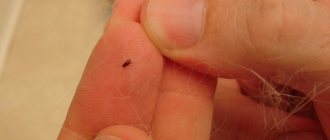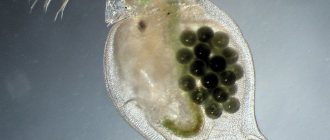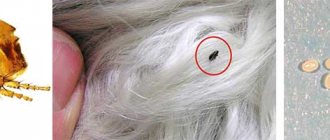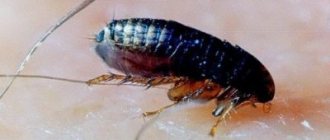Fleas belong to the category of parasites with complete transformation. In other words, young individuals that have just emerged from eggs are significantly different from their adult, sexually mature counterparts. Differences are observed both in the external structure of the body and in the way of life and food production.
How do fleas reproduce in cats? What are the distinctive features of their development cycle? How many of these parasites can be on an animal’s body at the same time? How quickly do fleas reproduce in cats? All this will be discussed in our article.
General information
Before I tell you how fleas reproduce in cats, I would like to say a few words about adult fleas. Sexually mature blood-sucking parasites can reach sizes of about 3-4 millimeters. Such insects have a dark brown tint. The soft tissues on their body are protected by a fairly durable chitinous shell. The body is somewhat flattened on the sides and covered with small fibers, which allows parasites to easily move through the animal’s thick fur. Fleas have three pairs of limbs. The longest legs are used for quickly moving over long distances.
Flea Density
Sensitivity to parasites in animals varies and depends on the class and specific breed. Some pets carry out regular and sometimes even overly fanatical grooming, while others are calm about the life of fleas on their bodies.
This factor directly affects the density of pests. In animals that are more tolerant of parasites, this figure is noticeably higher. If a cat or dog is allergic to insects, then they can clean their fur 24 hours a day, even if the infestation is minimal or completely absent.
Scientists have conducted research on the hygiene habits of different felines. Extremely clean cats cleaned out about 20% of parasites each day, or about 70% per week. That is, the average lifespan of one individual was about 5 days .
A less active cat got rid of 4% of insects per day (about 20% per week). It turned out that the parasites barely survived until day 20. You also need to take into account the age of the pet. Young animals are more susceptible to infection than adult animals.
The fact is that young cats and dogs simply do not have experience in hygiene and have not yet learned how to comb themselves properly. Moreover, adult pets have stronger immunity, thicker skin and a different arrangement of capillaries.
Egg stage
Let's start looking at how fleas reproduce in cats (the whole process in detail) from the very beginning. The life cycle of such insects begins from the egg stage. The clutches of parasites are very small. The shell of the eggs has an extremely smooth structure. Therefore, after being laid by a flea, they are poorly retained on the animal’s body and often fall off to the ground.
Most often, blood-sucking parasites create masonry on the floor, taking a liking to carpeting and all kinds of cracks in the coverings. Under favorable conditions, it takes several days for the insect to mature in the egg. If there is a low ambient temperature or an unsuitable level of air humidity, the process may be significantly delayed.
How long do fleas live in artificial conditions?
In the laboratory
In laboratory conditions, adult cat fleas live for months. In one artificial system, the maximum lifespan was 86 days. In another experiment, when fleas were fed human blood, their lifespan reached 139-185 days!
On an animal
The flea lives on the body of the owner for a long time, provided that the animal does not take care of itself. For example, one experiment showed that 94.1% of females and 89.2% of males survived for 14 days on cats. In another experiment, cats had their nails trimmed and were given conical collars to prevent grooming. After 50 days, 85% of females and 60% of males were still alive. And after 113 days, 76% of females and 50% of males were still living on cats.
Larval stage
How do fleas reproduce in cats in an apartment? After the eggs mature, larvae emerge from them, which, according to their appearance, resemble miniature worms, barely visible to the naked eye. The latter are able to maintain vital activity by absorbing all kinds of organic substances, be it dead epidermis, small grains of food or the excrement of adult fleas. During development, the size of the larvae increases significantly. Having gained weight, such individuals pupate, protecting their own body from unfavorable conditions.
How long do fleas live and how do they die in natural conditions?
Animal hygiene habits are the main factor in flea mortality
In real conditions, 95% of fleas die as a result of the host animal grooming itself. Unlike temporary parasites, such as mosquitoes, fleas, after feeding on blood, remain on the host’s body, where they live permanently. Therefore, the instinctive care of animals for their fur is the main cause of death of parasites. On the other hand, on the animal's body, fleas are protected from exposure to harsh environmental conditions.
How many fleas do cats clean?
Cats kill over 50% of adult fleas per week, averaging 3-12 per day. In one study, cats cleared 19.5% of female and 38.5% of male fleas in a week. In three weeks, a cat can remove 90% of fleas from its fur. Only 2-3% of insects will survive longer than this period. But some individual parasites manage to avoid purges and not get caught. There was a recorded case where a flea lived on an animal for 9 weeks.
How long does a cat flea live without a cat?
If a cat finds a flea, it eats it - this is how the vast majority of the parasite population dies. A small percentage of them end up released into the external environment. During cleaning, discarded fleas receive damage that causes them to die - their heads or paws are torn off. However, the body of an adult flea is tough and elastic, so some of them survive. But if after a couple of days the discarded fleas do not return to the host’s body, they will die of starvation.
Some animals groom themselves more thoroughly than others.
Sensitivity to fleas varies among individual animals. Some brush constantly, while others tolerate small to moderate amounts of fleas. The sensitivity factor directly affects the degree of parasite infestation. Animals that do not tend to groom their fur are preferred hosts for fleas. Those pets who are allergic to fleas clean themselves meticulously and quickly reduce the degree of infestation.
One study looked at the hygiene habits of four cats. The least active removed 4.1% of fleas per day (22% per week) from fur, and the average lifespan of parasites was 18 days. The cleanest cat cleared 17.6% of fleas daily (68% per week), allowing them to live an average of 5 days.
Animal age factor
Young animals tend to have larger flea populations than adults. This is due to the fact that young cats still lack experience in fighting parasites. In addition, adult cats have better developed immunity, thicker skin, and differently located capillaries.
Pupa stage
The flea larva, which has formed a kind of cocoon around its own body, is the most tenacious stage of the parasite. If favorable conditions are observed in the development sites, an adult individual capable of reproduction can form within a week. When the life of a young individual is potentially threatened by negative factors, the process is significantly delayed. Based on the sensitivity of special receptors contained on its body, the pupa determines the appropriate moment for the birth of an adult flea.
It is worth noting that fighting blood-sucking parasites that are at the pupal stage is practically useless. Such individuals are absolutely insensitive to the effects of household cleaning products and all kinds of disinfectants. At this stage of development, the flea is able to survive in sub-zero ambient temperatures.
How long does a flea live outside an animal at extreme temperatures?
Cold and frost
Sub-zero temperatures are lethal to fleas. At temperatures just below zero, adults emerging from cocoons die within 5 days. At 3-5 degrees above zero, fleas die within 10 days. The lower limit of survival is +8 degrees - at this temperature, 50% of fleas survive for 20 days. So in winter, fleas cannot live outside without an animal. Immature fleas are more sensitive to cold than adults. Eggs and larvae will not develop if the temperature does not exceed +13 degrees.
Heat and dryness
Heat above 35 degrees is deadly for fleas. At low relative humidity, fleas die within 2 days. In addition, the larvae die inside the cocoons at this temperature. The flea population does not survive outdoors if the heat above +35˚C lasts more than 40 hours during the month.
Adult stage
If environmental conditions are satisfactory for the insect, a sexually mature flea emerges from the pupa. Such individuals immediately begin searching for food. Having gained weight, the parasites begin to actively reproduce. The result is the appearance of new clutches both in the animal’s fur and around the entire perimeter of the home.
Life cycle of a cat flea
Cat fleas, despite their name, willingly settle on dogs, and are also capable of biting humans if there is no more suitable victim nearby.
A peculiarity of the life cycle of fleas is that they live more than half of it outside the body of their victim.
This feature caused the wide distribution of these insects, as it provided them with a more diverse food base.
The life cycle of a cat flea consists of the following phases:
- egg;
- larva;
- chrysalis;
- adult.
An adult insect can begin to mate and lay eggs only after drinking blood. Usually, mating becomes possible a few hours after the first successful hunt, and the first clutch appears two days after it. Flea eggs are smooth and translucent. They are not able to stay on animal fur and are scattered in different places, which allows the female to provide her offspring with a more extensive food base and lack of competition. Each clutch contains from 3 to 15 eggs, and in just one day a well-fed female can lay up to 50 of them. OVER its entire life, this prolific insect can give birth to 300-1000 new individuals.
Eggs with sufficient humidity and temperature hatch into translucent worms - larvae - after 2-14 days. The larvae live inside the burrows of wild animals, as well as in carpets, bedding, hay, sawdust or straw from the enclosure, old dirty rags and other objects on which you can easily find food - dead organic matter. The larvae are also able to eat flea excrement, which consists of undigested blood. The duration of this stage ranges from one to eight months.
The larval stage proceeds with three molts. After each, the larva increases in size. It ends with the formation of a pupa - a cocoon, inside which the worm transforms into an adult insect.
The duration of the pupal stage can vary from 2 months to a year. Pupae are highly resistant to adverse environmental factors. In this state, they are able to survive winter and lack of food.
Adult fleas live from 3-4 weeks to one and a half to two years. In the first case, the insects are large in size, in the second they become very small.
Mating process
We looked at how fleas reproduce in cats, the cat flea cycle. Now let's take a look at the mating process of such parasites. Having found a sexual partner, the female retracts the male’s special genital claw into her own body. Typically the semen exchange process takes about an hour.
After mating, about fifteen eggs are quickly formed in the female’s body. In cases where the female does not experience problems with access to food, the entire clutch is born simultaneously. If the flea suffers from food deficiency, the eggs reproduce gradually. If there is a good food supply, one sexually mature individual is capable of producing up to five hundred embryos.
How do fleas reproduce in cats? After the eggs mature, the latter are fired from the female's abdomen. Thus, masonry can end up on a wide variety of surfaces.
Long-lived fleas
Among these parasites there are real long-livers. The pattern is as follows - the larger the individual, the longer it can live. Therefore, insects that parasitize ungulate hosts are considered to be long-lived.
For example, the Tien Shan flea (speckled worm) can live on sheep for up to a year. It grows up to 7 mm in length.
Parasites that live on animals of the North fall into a long stupor in the cold winter. Their total lifespan is 16 months. And if the temperature is critically low for this species, their life is extended to several years.
Lifespan of fleas
To combat parasites, it is important to know not only how fleas reproduce. How long do these insects live? As noted above, much here depends on the level of humidity, temperature in habitats, and access to food.
Typically, fleas feel great in apartments, concentrate near heating mains in basements, live on the streets in the summer, and can live in hallways for a long time. The optimal ambient temperature for such parasites is considered to be within +20-25 oC. At the same time, the stage of transformation of the pupa into an adult takes a minimum amount of time.
On average, it takes no more than three weeks for a mature flea to appear, given favorable conditions. If during development the insect suffers from any negative factors, the stages of development slow down. In some cases, even fully formed individuals do not leave their protective cocoons for a long time. Under such circumstances, underdeveloped insects are capable of falling into inactivity for up to a year and a half.
As for adult fleas, their average life span is about six months. During this period, fleas show particular aggression towards potential victims. When there is a shortage of food, parasites can attack not only cats, but also other animals, and sometimes even inflict painful bites on humans.
Pupa stage
This is a very interesting part of the flea life cycle. The larva in the cocoon, that is, the same pupa, can stay there for different times depending on environmental conditions. If the pupa is located in an area with sufficient humidity and the temperature is optimal, an adult flea may emerge within a week. If environmental conditions are not normal, the emergence of an adult may be delayed for a long time. And this period is very long compared to standard conditions - it can be up to one year.
Thus, in any case, it takes a week for an adult flea to develop inside the cocoon. But when it comes out depends on environmental conditions. On its outer covers, the cocoon has many sensitive receptors with which it assesses the level of temperature and humidity. In addition, the flea is able to smell carbon dioxide, which is exhaled by warm-blooded animals. For this, she also has a number of receptors, telling her that it is time to crawl out of the cocoon - food is running nearby.
Scientists are puzzled by this phenomenon. How the pupae can stay alive for so long is truly a miracle of nature, because what they feed on all this time is not very clear. It is known that the former larval shell is used for food, but it would definitely not be enough for a year.
More importantly, if we consider the reproduction of these parasites through the prism of fighting them, then the pupa in this state can only be affected by very high or very low temperatures; chemical insecticides are not able to break through the protective shell of the cocoon.
As a result, after treatment, adult fleas appear again, and the person is tormented by the question of where they came from, unless they jumped off domestic cats again. Of course, it is impossible to fry or freeze a living space, so you need to try, oddly enough, to create optimal conditions for the adult individuals to emerge from the pupa, and then destroy them with chemicals, and a vacuum cleaner will help. At the same time, it is necessary to treat dogs and cats living at home.
useful links
If you are tormented by midges in the kitchen, find out how to deal with them in the article “Kitchen Drosophila Midges.”
Control of parasites
As you can see, fleas in cats can reproduce quite quickly. If small bloodsuckers are discovered, it is extremely important to immediately begin exterminating them. An effective solution to protect your pet from attacks by adults is the use of special collars impregnated with insecticides, as well as sprays and drops that are applied to the skin in the area of the animal’s withers.
However, the above actions are not always able to save the cat from subsequent flea attacks. Parasites are capable of returning again, developing from eggs that have spread throughout the apartment. Therefore, eliminating the problem should be approached comprehensively, resorting to disinfestation of the entire home.
Man and fleas
Unlike head or pubic lice, fleas avoid human contact. The parasite can linger on clothing for a couple of days and periodically attack its owner, but the insect’s natural habitat is animals with widespread hair.
Under artificially created conditions, fleas have demonstrated the ability to live on human blood. But in the natural habitat this is rare. The parasite is too large to reproduce safely on human skin. And it is much more convenient for him to move on fur than on a bare or bristly surface.
It is extremely unlikely that fleas will reach a person's head. The most they can do is jump to ankle level. And as soon as the pest begins to move higher, the person will immediately feel it. Once on the skin, a flea simply bites, drinks blood and tries to leave the uncomfortable place as quickly as possible. The bite can be compared to a mosquito.
How quickly do fleas die during treatment?
So, if you want to find a flea habitat, look indoors. Most often this is your pet's bedding, carpets, upholstered furniture, dusty corners and secluded places behind the baseboard, and cracks in the floor. Here you can often find larvae that look like worms.
But they are infrequent guests in clothes. They settle in the closet only when the room is heavily infested with parasites. They love places from which they can quickly get to the main source of food - an animal.
With proper treatment with insecticides, fleas die in 1-2 days. It is important to start by treating the area and then treat all pets. Remember that the insecticide does not penetrate into the very depths of the carpet. But it is there that there is a cluster of eggs, larvae, and numerous pupae. A durable cocoon protects the pupae from the effects of the most powerful chemicals.
This is why it is so important to re-treat the room. It is performed a few days after the main one.
It is better to use insecticides with a prolonged action. Even adults that emerge from cocoons after 3-4 weeks die from them. Remember that the properties of drugs weaken over time. Repeated treatment is necessary after 2-3 weeks. To remove the entire home colony, 2-3 high-quality treatments will be required.











